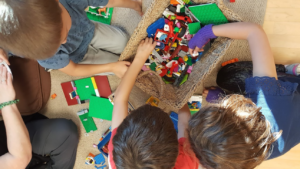Play is a means to early learning that capitalizes on children’s natural curiosity and exuberance. Play is a vehicle for learning and lies at the core of innovation and creativity. It provides opportunities for learning in a context in which children are at their most receptive. Play and academic work are not distinct categories for young children, and learning and doing are also inextricably linked for them. It has long been acknowledged that there is a strong link between play and learning for young children, especially in the areas of problem solving, language acquisition, literacy, numeracy, and social, physical, and emotional skills. Young children actively explore their environment and the world around them through a process of learning based play. When children are manipulating objects, acting out roles, or experimenting with various materials, they are engaged in learning through play.

Children play at Central Public School in the Extended Day Program “As children engage in various forms of social play and are supported to recognize the varied capabilities and characteristics of other children, they learn to get along with others; to negotiate, collaborate, and communicate; and to care for others”
(How Does Learning Happen? p. 24).
Children are offered choices of learning activities that reflect their developmental stages. The learning activities are designed by the extended day team to encourage the children to think creatively, to explore and investigate, to solve problems and engage in the inquiry process, and to share their learning with others.
“When children are fully engaged in their play, their activity and learning is integrated across developmental domains. They seek out challenges that can be accomplished … Through play, children learn trust, empathy, and social skills.”
How do educators support play-based learning in the extended day program?
- providing large blocks of time for both child-initiated and structured play; and
- guiding, shaping, engaging in, and extending play but not dictating or dominating it; and
- allowing children to be ‘in charge’ of their play – engaging them in the planning of the learning experience; and
- providing hands-on, concrete materials, tools and equipment that encourage children children to engage in different forms of play; and
- changing materials, tools, and equipment as needed, to guide, shape, enhance, and extend the learning; and
- asking questions to expand and enhance play; and
- observing, engaging, documenting to make children’s learning visible.
